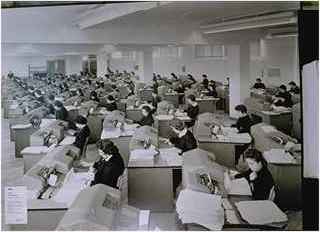
PUNCHED CARD EQUIPMENTS
_________________________
Modern computers were invented for several types of applications, some of them born during the Second World War -such as radar or cryptography-, but some coming back from the 19th century during the first industrial revolution.
Process Control card machines:
In the 19th century, the first industrial revolution
is based on mechanical energy, generally powered by steam engines. One of the most
sophisticated industry of the time is the textile industry. The Jacquard weaving loom is
the first digital process control application.
The automation of a loom requires: the recording of a sequence of commands
and the subsequent re-reading of that sequence.
Another contemporary application of a similar technology used by quite different
entrepreneurs are street barrel organ and entertainment automata.
Technology: Commands are recorded as one or several holes in a relatively resilient, however disposable, media; each hole carries a precise meaning according its position. The media is usually a tape or, more often, a loop of cardboard. The reading mechanism is either mechanical ( a point falls in a cavity when there is a hole in the cardboard) or pneumatic (the hole allows the airflow to perform a mechanical action). Much later, in the 20th century, the reader will be electrical (the hole in the cardboard will allow a source of electrical current to power an electromagnet performing the mechanical action).
The characteristics of this
"tape" control memory are the following:
-automatic reading
-permanence (not modifiable)
-variable but finite size
-devotion to a specific program
-machine-dependent encoding
Birth of punched card data processing:
Herman Hollerith (at the origin of IBM company) proposed, for the 1890 US
census, to use punched cards to process the census results. Punched cards are used
there to store and to retrieve data.
The numbers are coded on holes :
10 holes allow encoding of a decimal digit
2 additional holes allow the encoding of alphanumeric data as well as negative
numbers
A number is represented by a sequence of columns (field) in the card.
A deck of cards (a file) is characterized by an homogeneous positioning
of data (originally numbers). Each card must contain an identifier field.
The characteristics of data card
"memory" are the following:
-permanence (but some fields may be initially empty, so it can be added to)
-automatic reading
-the presence of an identifier field allows to reorder cards, change their order and
to sort them
-theoretically no limitation of the number of cards
-punched cards may be human readable (while before card translation by printing on the
edge, the process was hard).
Note: The process of using punched cards for statistics processing through several machines (or several instantiations of one machine) is somewhat similar to an automated workshop, a familiar process to industrialists of 1850-1950. EDP will use the word "batch processing" for such a process. Batch processing will reign on data processing shops until the 1970s, where it will be progressively phased out by direct transactional processing.
The first data processing machines:
The census application required:
-the preparation of paper documents to identify, group and codify data fields.
-the punching of data on cards
-the verification of data punched on cards
-the sorting of cards according census criteria
-the comparison of the value of data fields to count the number of occurrences
The machines are specialized by function:
The keypunchers (perforatrices,
in French) were initially exclusively mechanical. They had a purely numeric
keyboard (alphabetic data are possible by pressing simultaneously two keys). The keypunch
operator read the original document and keys data. She (rarely he) had a productivity
carefully measured at 3 to 6000 punches per hour.
Later, punching machines were electrically powered, decreasing the effort. They started to
use alphanumeric keyboard in the 1940s and the productivity increased to 7 to 8000
characters per hour. The errors and discarded cards are charged to the operator.
The key verifiers ( vérificatrices, in French). The operator performed a similar function to the punch operator, but instead of making holes, the machine compare the entered data with the original data on punched cards. In case of discrepancy, the machine stops and manual investigation is performed. In optimal conditions, the productivity reach 6 to 9000 key-punches per hour.

Punchers and verifiers operated as a pool of typist,
but the working conditions were still more constraining
(noise, paper
dust and productivity constraints)
Sorters (Trieuses, in French) are designed to order a file by criteria stored in the files themselves. The sorter works one numeric column at a time and put cards in one of ten receiving pockets. The cards are then collated by the operator. He (or rarely she) collates them from pocket 0 to 9 for an ascending order sort or from pocket 9 to 0 for a descending order sort. He put the cards back on the machine as many times as the field size requires.
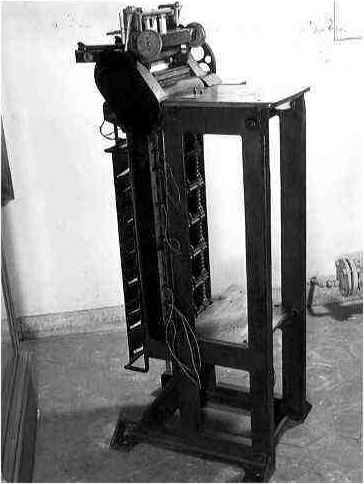
vertical sorter (1922) |
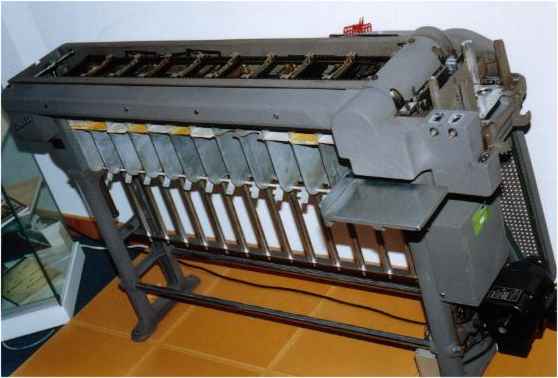
horizontal sorter E112 |
Punched Card (80 columns)
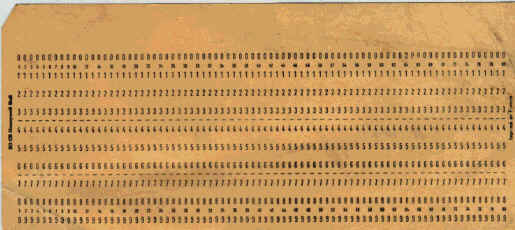
The initial tabulators (Tabulatrice,
in French) had the function to count a series of cards. Two successive cards are read
simultaneously by two readers positions. The data in a value field are compared and
if equal, a rotating mechanical counter (similar to those of mechanical calculators) is
incremented. When a difference appears in the value field, the machine is temporarily
stopped and the operator records by hand the value of the counter.
A programming device, somewhat similar to a panel with telephone manual jacks, (the
plugwires panel, tableau de connection, in French) allows
the programmer to
select the field specifications and to specify one of the several incremental counter.
|
|
This tabulator was built by Frederick Rosing Bull in 1923. It used punched cards containing 45 columns with round holes. It contains one rotating adder. It had card preselection, a significant speed advantage over Hollerith (IBM) or Samas competition at that time. |
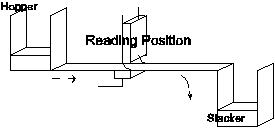
Card Reader schematics
The technology used in the electrical machines is based on relays powered by 48V DC rechargeable batteries. Memories (accumulators) of tabulators are made of rotating wheels.
Evolution of card equipment
Initial users of the first punched
cards data processing machines are often national administrations who specify their
needs and often require personalized versions of machines.
During the 1930s, the banking and insurance business begins to order punched cards
equipment and requests additional functions over what demanded the census type
applications.
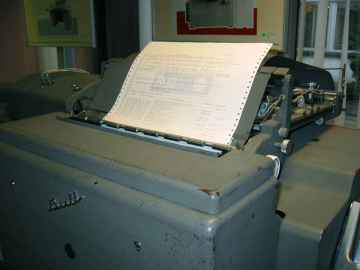
The new functions to be added to tabulating
equipments are:
- a printing capability, avoiding the human reading of counters
- the capability to subtract numbers (at card reading speed)
- a computing capabilities on larger fields and sometimes the ability to
multiply and divide.
In addition new auxiliary machines will be created:
- the collator (interclasseuse, in French) that
decreases sorting time.
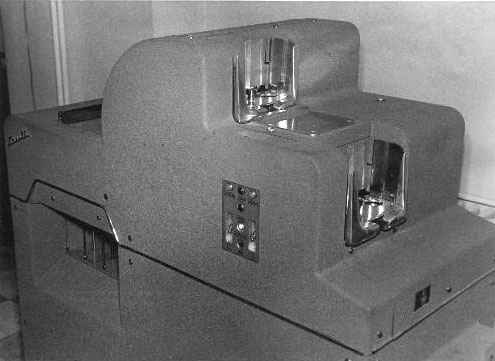
- the calculator (calculatrice, in French) that performs arithmetic operations from fields of a card and allows the automatic punching on the same card (requires an additional card punch position on the tabulator).
-the duplicator/reproducer/ punch machine (named by Bull a P.R.D. for Perforatrice, Reproductrice, Duplicatrice) to copy and verify card files.
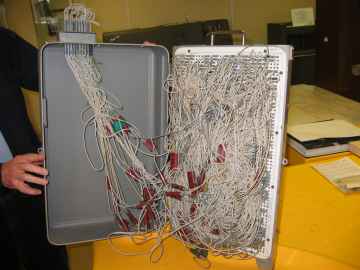
programming conexion panel of PRD
-the gang punch (named by Bull a PAS or PASOD)
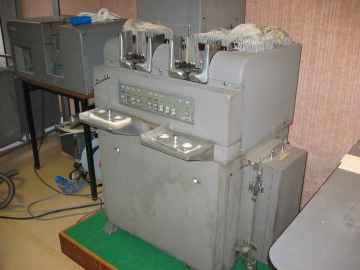
- the translator (traductrice, in French) prints the content of a card on the upper edge of the card.
-the reporting machine (reporteuse, in French) that can print number or text on the top of a card.
The technology will evolve relatively slowly. Small relays were introduced that brought faster (still milliseconds) switching time, but the increase in number of equipments brought a need for power generators groups still producing 48V DC current.
During the 1950s, the calculator evolved into a general purpose computer (the IBM 604, the Bull Gamma 3 ) that performs far faster computations and remove that the computation constraint as a limiting factor of the speed machines (then reaching a ceiling of 150 cpm) . a consequence of that evolution was the fast disappearance of calculators and the direct connection of the computer to the reader-punch (PRD) machine. That generation of computer still relied on fixed programming through plugwires panels.
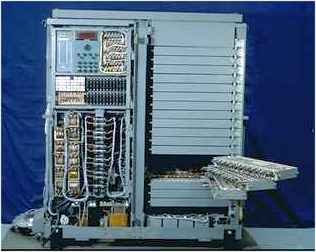
A first improvement was made on that generation of machine that brought together the heritage of the Jacquard loom and the legacy of census-derived card equipment. It is called card-programming (Programme Par Cartes, in French). The Gamma 3 used 16-bits instruction code, and a card stored 4 instructions on each line of cards. Recording up to 48 instructions was possible, while not recommended because augmenting the risk of torn cards The plugwires panel was still used to store frequently used subroutines (such as floating point operations)
Electronic Computers
The use of magnetic drums for tables, temporarily
files on IBM 650 and Bull Gamma ET started to change the organization of data processing.
Methods and jobs designed in the 1930s begun to evolve and started to drain more resources
in EDP applications. Probably, the major contribution to the evolution was their usage of
drum-stored programs, already introduced in the first generation of
scientific computers (ENIAC,...) that lead to the need for programming languages and a
drastic change in the data processing operations
At the end of the 1950s, Bull attempted to market a full new line of cards equipment at
300 cpm (Série 300) ; it used also an optional magnetic tape device (called Multisélecteur).
The simpler but quite successful Bull Gamma 10, developed in 1961, (or the card-IBM 1401)
were better transition machines between card equipments shops and general
purpose computers .
But the dusk of punched cards had begun. The general purpose computer, lead by the IBM 1401, took over in the early 1960s. where punched cards remained just an input (sometimes output) media for their last twenty or thirty years.
Rem: the background noise is sampled from a Bull sorter.
Note that all card equipment hardware were called by female names in the 1950s, even those that were served by female operators...
© Fédération des Equipes Bull, Victor Thévenet, adapted by Jean Bellec
Revision : 03 février 2007.